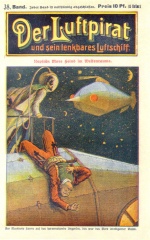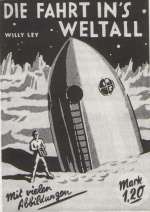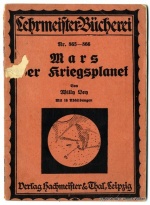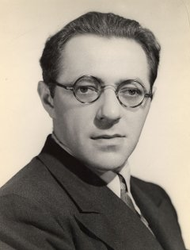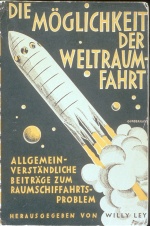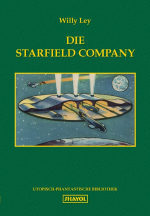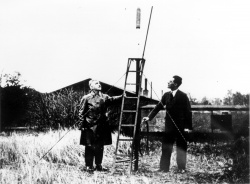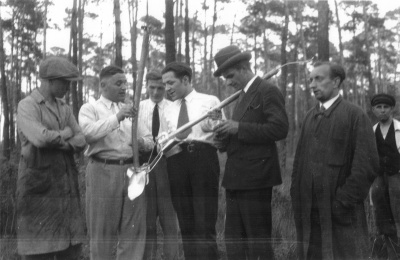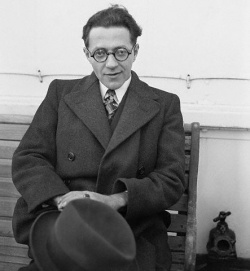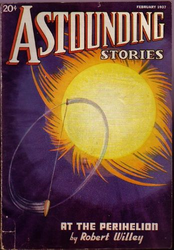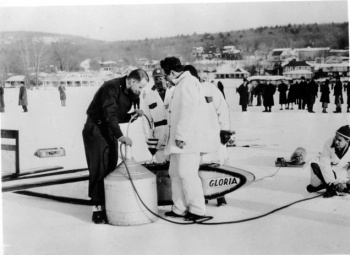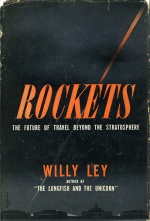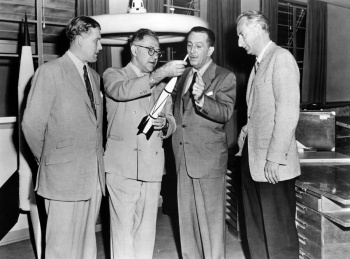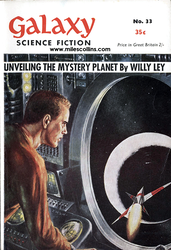Willy Ley – Berliner, Rocket Pioneer, Space Historian by Wolfgang Both
From The Space Library
Contents |
Abstract - Willy Ley – take the first steps into space with him
In the USA Ley is still a well-known evangelist of space flight, but in Europe he is widely unknown. When Ley left Germany in spring 1935 the rocket development had already been taken over by military research and been made secret. Secret until the first flying bombs fell on London in autumn 1944. Just at that time Ley's magnum opus "Rockets" was edited for the first time and made him into an undoubted expert on space flight.
Born in 1906 in Berlin he was a rocket pioneer in the Verein für Raumschiffahrt (founded in 1927). And he became a publicist and historian of space flight as well as a writer of science fiction. I came in touch with him via SF. We discovered his early novel "Starfield Company" (1929) and planned its publication. This novel gives an insight into the status of rocket development at that time.
We needed a biography which was collected from different sources (still growing) and appeared for the first time in Germany as an annex to the novel.
Both the scientific community as well as the science fiction fandom honored Willy Ley as a person of excellence.
Willy Ley – Berliner, Rocket Pioneer, Space Historian
by Dr. Wolfgang Both, Berlin
"Ideas, like large Rivers, never have just one Source."
This quote from Willy Ley "ideas – like large rivers - never have only one source" also applies to the development of space travel. He was just twenty-one, when he recorded his first insights into space, not only in scientific articles, but also literary. Willy Otto Oskar Ley was born on October 2, 1906 in Berlin. His father Julius Otto Ley was a wine and spirits merchant in Königsberg in Prussia, thus his second middle name. The liquour factory JO Ley stood in the Köttelstraße 6. His mother Frieda, maiden name May, was the daughter of Protestant sexton Oskar May from Berlin. From him came Willy's third name.
To expand the business, his father went to America in 1910, then to Britain, where in London he opened a deli in 1913. His mother followed him there, allowing Willy her three sisters to stay with the grandparents. With the outbreak of World War I, his mother returned back to Berlin quickly, carrying in her arms Hildegard who was just eight months old, while his father was interned by the British on the Isle of Man. He would not return to Berlin until 1919, when Willy was already in school. During the difficult war years, his mother had to care for the children alone so she worked around Berlin as a milliner. They saw her only once or twice a month. Willy grew up well protected between his aunts and grandparents in the Scharnhorststraße 24. He was a good student and was very interested in science and technology. In his room he had some terrariums with small reptiles. His aunts did not like them at first, but then the animals were quite "nice". Despite the hardship of those years Imperial Berlin offered him a lot of stimulation. One of his favorite places was the Museum of Natural History - today famous for its collections and large dinosaur skeleton – where he spent many Sundays. It was just around the corner in the Invalidenstrasse. The visits there encouraged him to become an explorer. He wrote about this in a school essay on "What I want to be when I grow up, and why?" He was very disappointed when he was given a bad grade although the teacher did praise his writing style and reasoning. But the whole thing was seen as nonsense. How could someone with his background have such a goal? Before the whole class his desire was presented as unattainable. But he was not convinced by the speech, so he stuck with his career aspirations. [1]
Because of the books of Jules Verne, Kurd Lasswitz and Carl Grunert, and the comic series the "Hijackers" (Luftpirat) he came into early contact with the idea of space travel; especially Verne's book "Hector Servadac's Adventures on his Journey Through the Solar World" which fascinated him even more than the "Trip to the Moon". This awakened his early interest in astronomy. Willy had a talent for languages. So he attended the 5th Municipal Realschule / Spruce Junior High School No. 5 in Stephanstraße 2 on the other bank of the Spree, (now Moses Mendelssohn school) where he took courses in Latin, English and French. He liked to read the classics in their original languages. Later, other languages would be added to his repertoire. At the age of threeteen he prepared his first repulsion experiments. A toy ship was equipped with a spirit stove and a boiler. The boiler had two pipes to the rear. The steam stream moved the little boat. It worked so well, that some day the ship vanished quite fast. Then he tried to launch air plane models with steam power. It was complicated to install a ligth and tiny heater and boiler. And then the bioler exploded, he was covered with metal and glas pieces. He was injured a need an operation to remove some splinter. The was the first explosion of a repusion engine, but not his last.
When he expressed his desire to study, it was unusual and difficult for the family of a small businessman. Germany was living through the difficult post-war years with high inflation. The family consulted the Protestant clergy of their community, who encouraged them to support his ambitions. So Willy Ley took a job as a clerk in a major bank to earn his degree himself. At this time, that was typical for a working student career. He started in 1923 in Berlin and finished his studies in zoology, paleontology and astronomy in 1927 at Königsberg. After that, he was a freelance writer and journalist based in Berlin. During this time he was briefly a member of the NSDAP, Gau Berlin. His membership ended 1928. He then worked for the Social Democratic press. His contributions to science and technology issues appeared in various newspapers of the SPD.
During his studies in 1925 , in a Berlin bookstore he discovered the new edition of Max Valier's book "Advance into Space". He spent all of his money on it and even bought "The Accessibility of Celestial Bodies" by Walter Hohmann. So he had to walk all the way home on foot from the Dorothenestraße on Friedrichstrasse. In the Dorothenestraße was the office of Ferrostaal AG, where he earned his degree money working as an accountant.
The vivid, almost effusive Valier descriptions of "the flare of the spaceship" and "the conquest of starry worlds" fascinated him, but did not satisfy him. So he went "back to the sources", to Oberth's seminal work "The Rocket into Interplanetary Space" (1923). Ultimately, he was dissatisfied with Valier's popular book (Oberth was too), so in 1926 he wrote a paper entitled "The Journey into Space", which sold out instantly in several editions.[2]
He was just nineteen years old, had begun to study under the difficult economic conditions of severe inflation, and now had made his move to become a journalist and chronicler of the first steps into space. The next opportunity would arise in much the same way: in the autumn of 1926, the Archenhold Observatory in Berlin-Treptow opened an exhibition on Mars. A friend pointed it out to him. They arranged to meet and visited the observatory together. They considered not only the Mars photos and the collection of books on the subject. Ley also visited with the son of the director that week and learned that the replicas of the Galilean telescope had shown that you really could not see details on the Martian surface with them. The visit then encouraged him to write the book "Mars, the War Planet" (1927).[3]
At a meeting in March 1927 at a lecture in Wroclaw, Max Valier and Johannes Winkler exchanged ideas on this subject, discussing the need to join forces. Valier pointed Ley in the direction of the unwritten history of rocketry. So Willy Ley was not just a chronicler of these developments but he himself accompanied and drove them forward. He was also a recognized historian of space exploration. Numerous works, starting with the "Outline of a History of the Rocket" (1932), testify to this.
After the "Spaceflight Club" was established on the initiative of Valier on 5 July 1927 in Breslau, Ley received a letter from Valier in which he was invited to become a member. Other figures such as the writer Otto Willi Gail and Prof. Oberth, were also invited by Valier and Winkler - the first chairman of the association. So in August 1927, Willy Ley became member no. 20 in this new club of space enthusiasts.
Willy Ley and the Verein für Raumschiffahrt
After completing his studies, Willy Ley began his publishing activities. In lectures and articles he devoted himself to space, but also to his interests in zoology and paleontology. Therefore his first monograph contained discussions about lizards and dinosaurs: "Dragon Talk" (1927). The monograph "Mars the War Planet" (1927) was an outlineof previously published studies and reflections on our neighboring planet.
The sluggish sales of Hohmann's work indicated that this issue had to be popularized differently. The club magazine "The Rocket" could not afford it. Therefore, Willy Ley conceived the plan to publish an anthology with contributions by several scientists. It should be a "readable" book, perhaps not for the man on the street, but rather for scientists, engineers, teachers and senior officials who might be convinced. In the preface, he wrote: "My thought then was, if possible, to put together a comprehensive missile book using all the German language authors who had publicly affirmed their position on the space issue. That should be understood simultaneously by as many as possible, because we aerospace people rely more on the interests of the public than any other technical or scientific branch." It was hoped that new members would be obtained for the club through the publication to acquire the necessary funds for rocket experiments.
Ultimately, it was the goal that "a German rocket carrying a German ship would arise from the earth." So he wrote leading club members like Winkler, Oberth, Valier, Hohmann or Hoefft and asked for their contributions. Ultimately Karl Debus, Hermann Oberth, Franz von Hoefft, Guido von Pirquet and Friedrich Sander, next to Ley himself, were represented in the "Possibility of Space Travel". Only Max Valier was not able to provide a contribution of the history of the rocket to the deadline because he had become entangled in his rocket experiments with Fritz von Opel. Everyone at the club was annoyed. While they had worked for months around a serious presentation of the subject - they wanted the book to make an important contribution by early 1928 - and they described it as a "cultural mission" to create the spaceship, Valier was seen in the press riding unsafe powder rockets. The club "gnashed its collective teeth", as Willy Ley later remarked.[4]
In the summer of 1928 there was a fierce verbal battle between the proponents and opponents of space travel. In the journal of the Association of German Engineers, Prof. Hans Lorenz of the University of Gdansk claimed in 1927 that a departure from the Earth would not be physically possible. They met in Zoppot at the meeting of the Scientific Society for Aviation in June 1928. Willy Ley, who attended the event, was able to determine that although Oberth was not a brilliant orator, he took Lorenz apart in only fifteen minutes and once again pointed out his deviations. Lorenz had to concede that he had only read the first and last pages of Oberth's work and was completely embarrassed. Afterwards, one of the bystanders commented to professor Oberth that he had never experienced seeing the contribution of a renowned colleague "ironed flat in such a short time". In the afternoon there was an opportunity for a first personal meeting between Willy Ley, Hermann Oberth and his wife in Zoppot. They drove back to Berlin, where Professor Oberth wanted to hold talks with senior officials. At the same time the club considered that it had developed magnificently over the first twelve months. It already had more than 500 members, many beyond Germany and Austria. Many basic tests for thrust measurement, the pressure on the human body during acceleration, flight experiments and more theoretical considerations had been made. There was also the publicity from the rocket car experiments by Opel, Valier and Sander. A basic stock of 1,000 Reichsmark had been saved through contributions and donations.
While Willy Ley revised the first edition of his anthology, a letter from Oberth reached him at his office. Fritz Lang was looking for a scientific adviser for his film "The Woman in the Moon". Max Valier had offered, but had not been hired. [5] Instead, Fritz Lang sent a telegram in September 1928 to Medias and Oberth asking him to cooperate. Oberth called from his Berlin hotel immediately and asked Willy Ley to be involved. He had caught a terrible cold in Romania, but both saw an opportunity to bring their space ideas to a wider audience with this offer. Oberth was terribly upset about the depiction of moon walks without a spacesuit - the silent film required being able to see the actors' faces. Oberth was hired for the next few months as a consultant and Ley was commissioned for a dozen articles about the shooting, which then appeared in the publications of Ufa film company and in daily newspapers. In mid-January 1929 they met on the film set in the Ufa studios in Neubabelsberg. The inventor Hermann Ganswindt was also present..
As a layman, he saw extensive work for the preparation and realization of the filmand got the impression that here was the means for their academic work. So he joked to Oberth: "Professor, we are here in the film, with Fritz Lang. Here money is no object. Here there are the means to make your formulas a reality." So the idea for an Ufa publicity rocket originated. Before long, Ufa presented 5,000 Reichsmarks for the manufacture of a rocket to be made available in time for the world premiere. In early July 1929, both sides signed a contract. In addition to the studios in New Babelsberg a laboratory was set up for Oberth and he began experiments with rocket nozzles and fuels. He developed and tested the "cone nozzle" that distributed gasoline droplets evenly during combustion with oxygen but he suffered severe injuries in a gas explosion in early September 1929.
During this time, Willy Ley's novel "The Starfield Company" appeared as a weekly supplement in German newspapers. It was announced by the Berlin Roderich Fechner publisher for publication, but it was not issued, since the company went bankrupt. [6] As he noted in his consideration for the script submission of Thea von Harbou, enough space novels had already appeared in recent times, "for which I'm not entirely innocent". Nevertheless, he tried to have a translation finished in the United States. But even this plan failed; as did an attempt to establish a science fiction magazine based on the American model. The requested publisher Dr. Selle-Eysler of Berlin rejected this idea immediately. In his novel Ley incorporated the current state of rocket research. The questions around the nozzle are addressed, the fuels used or ignition configuration are worked on by Robinson, Prof. Mizumdar and Cora and are subjected to the necessary tests. As described in Oberth, hydrogen and oxygen are the fuels used. Here, the researchers relied on the results of German, Russian and American scientists who have made "similar experiments years ago" (p.42). After all, the action of the novel took place in the year 1980. Also, the term "oven" for the combustion chamber comes from Oberth. Ley took the starting principle of his spaceship from him. For this purpose, it is towed by two airships to a height of more than ten kilometers and launched from there. His spaceship already has the capability of a Space Shuttle, can start automatically and land and maneuver in space. For this purpose it has a pivotable steering nozzle. Even the idea of "gimballing" comes from Oberth. Also featured are Ley's ideas of the creation of artificial celestial bodies in a geostationary orbit (p.57). This also goes back to Hermann Oberth, who designed the artificial celestial body in his work as a "little moon". Oberth saw them as a way to build seamless telegraphic connections around the globe via space stations to observe the Earth and photograph it; he also realized its strategic importance. The rockets that are fired in the novel on the artificial moon base of the aliens are structured according to the multi-stage principle. With the designation "A1" Ley jumped years into the future. For the first rocket engine, which was tested by Wernher von Braun in early 1933, was called "Aggregat 1", short for A1.
But no missile was completed for the film release of "Woman in the Moon". As an article from 1930 shows, Ley tried to apologize to the general public and to justify it with Oberth's obligations in Romania. At the same time, the journal article showed the real state of rocket development, although Robert Goddard had started as early as 1926 in the USA with a missile with liquid propellant (which had remained unknown in Europe). But they were still far away from the target date of the Ufa publicity rocket. Oberth asserted later, he would never "invent to a date" again.
Although the film was a box office hit, the number of members in the club did not grow as hoped. At the end of 1929 the membership figures stagnated at 600. Earlier Winkler got himself into financial difficulties through production of the club magazine "The Rocket". The cover picture was dropped and the number of pages was halved. Willy Ley was now trying to make the journal more attractive by a substantive expansion and presented in May 1929, the "entertainment supplement". His fee agreement, as the editor, implied that he would not be paid until there were 1000 club members, but this never happened. With the December 1929 publication, due to high liabilities, it had to be stopped. The initial euphoria was gone and the global economic crisis showed its effects. To replace this important means of communication for the members, from April 1930 Rudolf Nebel and Willy Ley gave out the club "Bulletin".
One evening, when Willy Ley came home, he was met by the sound of classical piano. He went curiously into the room; there sat a young man at the piano, passing the time with piano exercises. He remembered that it was probably Beethoven's "Moonlight Sonata". This turned out to be Wernher von Braun, freshly baked graduate and member of the Association since June 1928, hoping that Willy Ley would put him in contact with his idol Hermann Oberth. He, too, was infected by the idea of space travel. After an initially poor academic performance, he discovered mathematics and the natural sciences as his passion on the way to the stars. Early sketches and short stories proved his desire to turn himself to the "wheel of progress". After a successful high school exam back in his home town of Berlin, he committed his free time to the club.
At the same time a shift began at the Association for Space Flight, from Wroclaw to Berlin. At the beginning of 1929 the first talks were held in Berlin to set up a branch there. This took place officially in August as the patent attorney Wurm managed the Berlin branch. On October 15, 1929, the premiere of "Woman in the Moon" took place, with an article by Willy Ley and other journalists reporting on this event. Winkler was moved from Wroclaw to the Junkers works in Dessau in September 1929 and Max Valier came at the beginning of 1930 to Berlin to take up new experiments with liquid engines in the Heylandt company.
The club was now active in Berlin more than ever. After Winkler had learned from Willy Ley in January 1930 that Oberth was still in Romania, he decided to spend more time with the club and promote the idea to the public in order to regain lost confidence. On 4 March 1930, the first public meeting was held. In April, 200 guests attended the lectures of Winkler and Nebel on the problems of space. In May there was a promotional week on the Leipziger Platz and in the Wertheim department store. The Ufa rocket was used for advertising purposes there after the club had acquired it (proposed by Ley) for 1,000 Reichsmarks.
In the interim, Rudolf Nebel had succeeded in speeding up the experiments. At the beginning of March, 1930 he had received an advance from the Reichswehr of 5,000 Reichsmarks, for the presentation of a firing in the weapons test office. Nebel, whose team now included the precision engineer Klaus Riedel, worked on modified engines and missiles, and only made the necessary minimum (minimum missiles - Mirak).
Ley met with Max Valier to try and get him more involved in the association's work and coordinate their activities. A few days later Valier came in to do an experiment in his Berlin laboratory and was killed; he was the first victim of Astronautics.
In mid-July 1930 they carried out a first test in the Chemical-Technical Imperial Institute and were accredited for the performance achieved. The redevelopment of the mist fan spray nozzle was not working, but Oberth's cone nozzle yielded results, for which Dr. Ritter of Reichsanstalt granted a certificate. Then Oberth went back to school work in Mediasch while Nebel, Riedel, Heinisch and von Braun continued their experiments on the field behind Riedel's grandmother's farm in Bernstadt ad Eigen in Saxony. Here some successful combustion tests were carried out and reported on postcards sent to Berlin. However, the planned rocket launch in early September ended with an explosion of the engine, so it was decided to continue the work in Berlin. Willy Ley did more and more of the club organization and moderation between the Chairman Winkler, Oberth, the new managing director Rudolf Nebel (who actually would only collect the overdue membership fees) and the head of the Berlin office Erich Wurm. Therefore he filed an application for inclusion on the Board in August 1930's. On November 1, 1930, he was confirmed as Vice Chairman, while Oberth took over the chairmanship of Winkler.
Messages from the VfR already appeared in 1930 in the Bulletin of the American Interplanetary Society. [5] In the summer Willy Ley had, through his correspondence with friends in the US, made contact with American science fiction. The American author RF Starzl sent him some copies of WONDER SCIENCE QUARTERLY and other magazines. Ley took the opportunity in turn to write to the editor and report on the activities of the German aerospace group. [6] At the same time, he wrote in the SPD paper Vorwärts on "Science Fiction in USA". This he also mentioned to the American readers in his first letter of September 1930, where he, among other things wrote that he had given lectures on the "History of the rocket" and for "science fiction". Simultaneously Oberth, Winkler and Nebel had given lectures on the topic of space travel. Because the first space magazine "DIE RAKETE" had to end its appearance under the leadership of Johannes Winkler at the end of 1929 on account of financial problems, now Ley and Nebel published the "Communications of the VfR – agency Berlin" to inform the members about the next steps and their successes.
Because the trials had shown in Bernstadt, that you needed a secure test site, they now searched in and around Berlin. The end of September 1930, Nebel succeeded in leasing a portion of the training area Berlin-Reinickendorf for 10 Reichsmarks. The grounds of the former ammunition factory near a police barracks was far enough out of town to prepare in the near future for engine tests and missile launches. The first rocket launching test site in the world was built on the northwestern edge of Berlin. From October 1930 to March 1931 they were cleaning up and decorating. In addition to the many German members also more and more foreign scientists and teams connected to the Spaceflight Club. The correspondence grew, so Willy Ley took over as vice president of this task and the new department "abroad". At the time there were greetings from Hugo Gernsback, RF Starzl and Lilith Lorrain. Perelman also sent a report on rocket research from Leningrad in the Soviet Union, which was published in the February releases.
At that time Ley estimated that at the end of 1930 the first important purposes of the association were reached:
- through publications and lectures the theoretical foundations for space were laid,
- a serious picture of Astronautics had arisen in the public's awareness
- the club had collected a considerable amount of experiments and equipment,
- engines developed had passed a first performance test and had even been certified,
- the rocket airfield had its own testing grounds.
Thus began a good basis for preparing the next steps towards space. The first successes would be prepared soon: On February 21, 1931 for the first time a rocket was lifted under its own power from European ground. This was Johannes Winkler in Dessau. On March 14, his rocket fulfilled a proper flight. [7]
At this time, Ley was able to publish his first SF short story (under the pseudonym Robert Willey) in the MAGAZIN. In April 1931, the chairman of the American Interplanetary Society (AIS), G. Edward Pendray, visited the rocket airfield. He landed on 10 April 1931 at the Berlin-Tempelhof airport, where Willy Ley received him. They explained to him the progress of their work. They arranged a test run demonstration and also arranged for more intensive cooperation. For this, the American side wanted to support the German experiments with financial resources. Even the formation of a network of organizations across the United States, France, Germany, Austria and Russia was discussed. In the August issue of Popular Science Monthly a multi-page article appeared on the state of rocket research in Germany, especially in Berlin. A summary of all notes with sketches of types of rockets from Berlin was published by Pendray in the July issue of the AIS Club releases.
A few weeks later, Klaus Riedel had the next successful ignition in Berlin. Nebel happened to be at a naval exhibition in Kiel as the engine began to move the bench slowly upward. Excitedly Riedel called Ley and reported that "the baby has done the business during the test run, went up like an elevator, fell back and its neck was broken." The "neck" was a fuel line, which could be quickly replaced, so a few days later the new "repulsor" took off and flew about 600 m. The term "repulsor" was proposed by Willy Ley, to distinguish themselves from the other Mirak solutions and goes back to the novel "On Two Planets" by Kurd Lasswitz. The report on this first Berlin flight landed right in Nebel's mailbox; he found the message after returning from Kiel.
Despite these achievements, the Board had stated that the financial resources were not sufficient. Only 150 paid members were in the club by mid 1931. If not for the patron Hugo Hückel - who likewise funded Winkler - the development would have been over. Since Oberth had surprisingly exited the club, the whole club organization was now just Willy Ley. This organizational deficit gave Rudolf Nebel an advantage and he increased his influence as manager and "head of the missile airfield" considerably. His team reached levels of one kilometer and the test specimen had a safe landing due to a parachute, in August 1931. This parachute and those for other missiles on the airfield were sewn by Klaus Riedel’s girlfriend.
In the autumn of 1931, at the urging of Hückel, Johannes Winkler came to the rocket launching site in Berlin, but the teams did not agree to cooperate. Nebel claimed leadership of the team at the test site, while Winkler insisted on being the technical lead. Ley always found only closed workshop space; it was Hückel's intention to share the labor and technology, including the measurement accessories and Dewar bottles. But this did not take place. Winkler felt that the treaty with Nebel just reset his successes. So in 1932 he sought out new launching places for his model-2 rocket.
The new chairman, Major von Dickhuth-Harrach, took over in December 1931.A veteran military man, he replaced Willy Ley as the leader of the club. So they could concentrate on the association's work, they sought an organizational separation of rocket club and airfield. Von Dickhuth confused the situation, but the consequences were not clear. Nebel used the opportunity to obtain new monetary supplies for his activities from the board of directors.
Wernher von Braun was elected to the board of the association, in spite of his youth, on the recommendation of Willy Ley. Willy Ley took a break for the first time and traveled for a week to his parents in Königsberg. He constantly gave interviews, did lectures and seminars; on one occasion he slept for a full day on his return. At the same time, he could be at the site figuring out which ratio of water and alcohol should be maintained so that the mixture would still burn. His father Julius Ley knew of thise and of course was a help. Thus, Riedel was able to replace the explosive fuel-oxygen mixture with an alcohol-water-oxygen mixture. Willy Ley knew full well that these experiments were still dangerous: for many years he carried a splinter of an exploded rocket motor in his body.
Nebel arranged a rocket test in spring 1932 with the army weapons office in Kummersdorf. In July, 1932 a flight would be sent to more than 1,500 m for which a premium was offered. But when the flight distance wasn't achieved, the military classified the whole thing as a failure and only paid 1,500 Reichsmark. At the test site was the young student Wernher von Braun. In November he became a civilian employee for the Army Weapons Office at Kummersdorf when Major Becker and Dornberger had convinced him that rockets could only be built successfully by the military.
Further activities for Nebel include the curious chapter of the "Magdeburg pilot rocket". After the failure with the military it was developed in the fall of 1932. This was to be an eight-meter high rocket, which could carry a man. For this the city of Magdeburg made 20,000 Reichsmarks available for a launch site. At the same time a search for proof of the hollow world theory was taken up. After the association had put out the Mitteilungs letter, Nebel published his "Communication sheet of the rocket airfield", as well as a pamphlet "Raketenflug" at the end of 1932. Although the club was responsible for all of the employment activities in the rocket airfield (volunteer labor service), the beneficiaries were the aerodrome and Nebel himself. This led to his further alienation.
In the spring of 1933 von Dickhuth-Harrach gave his deputy Ley a commission to compile a dossier on Nebel. When there were discrepancies in the review, the board of directors pulled the emergency brake: They indicted Nebel at the public prosecutor's office for fraud and expelled him from the association in October 1933.
At the same time Nebel tried to found a new club "Berlin rocket launching site". However, this was thwarted by the Imperial Defense Ministry. With the seizure of power by the National Socialists, the situation changed fundamentally.
Indeed, the Nazis also tried to take over the association. But in the board of directors were only "Aryans" and the chairperson was a former front-line soldier, so the young Nazi troop departed again. Prosecutors declined an indictment of Nebel at the end of November 1933. Thus Ley and von Dickhuth left the association for interplanetary aviation at the end of 1933 and changed (with some other members) to the association for advanced traffic technology. Von Dickhuth took over the club presidency. This club had been founded in 1920 by the inventor and patent attorney Dr. Otto Steinitz. Temporarily he worked as a patent attorney for Oberth. Willy Ley also worked with him and the family. Immediately, Willy Ley again took over the written management of an association magazine "DAS NEUE FAHRZEUG," which appeared from February, 1934 regularly until 1937. And he tried to carry on with Steinitz and von Dickhuth-Harrach's own rocket developments.
Willy Ley leaves Germany
But after 1933 the atmosphere in Germany suited Ley no longer. He said in May 1934 in a letter to GE Pendray: "I should be a little blonder in these times." His black, curly hair and his appearance did not correspond to the Aryan racial ideal. On one occasion when he was with a young blond woman walking in Berlin she was insulted, asked why was she walking around with such a "filthy Jew"? As he later told the anecdote, he cited the ironic fact that while he was Lutheran, the young woman was Jewish. Early in 1934, as the Berlin club already showed signs of disintegration, Philip Cleator came to Berlin and met with Willy Ley and Rudolf Nebel. Ley was then a member of the British Interplanetary Society (Member number 390). Cleator and he had met in 1931 through the SF magazine Wonder Stories, where Willy Ley reported the German activities and thus encouraged the British to begin their own club. They would do this in 1933.
As the Reich Propaganda Ministry specifications restricted reports of missiles, his working conditions were limited. Thus he prepared an official "journalist's travel" abroad. In the letter to Pendray he wrote that he wanted to see the world, especially England and the USA. In October 1934 Cleator received a mysterious letter from Holland, which a friend had sent from there. In this report Ley told him that the mail would be opened and in the future please do not to use official envelopes or letterheads of missile companies; "rocket" would become a taboo word. In an intensive letter and telegram exchange with Pendray he prepared a trip to the US. He sent his books and pictures in one package. Pendray vouched to the US authorities for him. But from the US Consulate in Berlin, he received only a month visa, because of his poor eyesight in one eye, sadly no permanent visa.. At the end of January 1935, he had cabled Pendray that his passage was confirmed and for him it "fulfilled an old dream." Nevertheless, on February 3, 1935 he climbed on the train at Bahnhof Zoo to Dusseldorf, from there to Hoek van Holland, took the ferry to Harwich, and then the train to London. In his pocket he had the maximum allowable ten Reichsmarks in the form of two new five-mark pieces, and the US tourist visa for 1.25 Reichsmarks. In London, he exchanged the German money for shillings and met with his old friend Prof. Low of the British Interplanetary Society. Then he went to see Philip Cleator in Liverpool. In Liverpool he was waiting for a passage to the United States. His booked trip on MS "Doric" was canceled due to a lack of passengers, so a few days later in Southampton he embarked on the "Olympic".
On February 21, 1935, he arrived in New York, where his acquaintances from the American Rocket Society were waiting for him. He was received by G. Edward Pendray, who supported him in the immigration formalities and vouched for him. Immediately after his arrival he prepared a speech on missile developments in Germany. This took place on March 8, 1935 in front of an audience of 800 as part of the events organized by the American Interplanetary Society.
In the early years he was denied full employment in the US due to immigration laws. His work with translations kept him afloat and earned him up to 50 US dollars a month. At the end of 1936 he also began to write SF short stories. The first was published in February 1937 in the SF magazine ASTOUNDING ("At the perihelion"). This brought additional income. To differentiate from his scientific work, he used the pseudonym Robert Willey. During this time, he was able to attend numerous missile tests in the US and carried out experiments himself. In addition, he reported in articles that appeared in Germany and Great Britain after his departure. The magazine "The New Vehicle" published a series of articles in 1936 about the rocket experiments at Greenwood Lake. [10] The New York stamp dealer Frido Kessler had hired Willy Ley (and other missile specialists) shortly after his arrival in April 1935 to do a rocket mail shot. Ley brought his engine developments from Germany to the task. In 1937, he spent some time in Havana, Cuba awaiting a new visa. Through attending American films, he improved his English skills. His immigration conditions improved and he went from Cuba to Florida. Briefly, he was married to the German journalist Margot Hübener who worked as a font manager for the National Federation of German press in the United States. This liaison dissolved quickly.
Willy Ley Publicist and Rocket Specialist
His SF stories brought him in contact with Science Fiction fans and other authors in the USA, among others Robert Heinlein and Arthur C. Clarke. In January, 1939 in one SF meeting on Long Island he made a presentation. These contacts he would hold on to for the rest of his life. A lifelong friendship connected him with other emigrants like Herbert Schäfer and Fritz Lang. In the beginning of 1940 he took over the editorship of the New York newspaper PM. Here he got to know his wife Olga, a Russian exile. They married on Christmas Eve in 1941. In January, 1943 he received a military call-up order, butwas taken out of service again on account of his poor eyesight. Their daughter Sandra came into the world in 1944. In the same year his work "Rockets" appeared and Willy Ley was naturalized in the USA.
In autumn, 1944, he was still skeptical about the rocket attacks from Germany on Great Britain because rockets would be too inexact. At the beginning of 1947, at the US testing ground at White Sands he was to observe the test flight of a captured V2 rocket (however, it was a false start). At the end of 1944 when the reports on rocket attacks on London increased, he started to collect material. Generally he supposed Prof. Oberth was behind these developments. He would get clarification only with a visit from Wernher von Braun at the end of 1946. [8]
Through the mediation of Robert Heinlein, he came to the Washington Institute of Technology in 1945 in the hope of being able to develop rockets for meteorological purposes. This was not fulfilled ultimately because the German rocket specialists from 1946 took over these tasks. So he became a freelance writer and journalist.
In late 1944 his parents fled from Königsberg before the front in the direction of Germany and arrived early in 1945 at Dresden. They experienced the Allied air raid, his father passed away there due to the strain of their flight. His mother moved with his sister Hildegard and continued to Wiesbaden. His daughter Xenia was born in 1947.
Shortly he met Wernher von Braun again after more than ten years. Von Braun had arrived in the US in September 1945 with the first group of his Peenemunde rocket team. On December 6, 1946, they met in Ley's New York apartment, opened a bottle of wine, talked, smoked, opened another bottle and exchanged stories of the intervening years until the early morning. All these new findings were the same as in his famous publication "Rockets and Space Travel" (1947). For this edition he made contact with the famous illustrator Chesley Bonestell, who illustrated the upcoming propaganda series with Wernher von Braun on Astronautics. One of Ley's best-selling books was "The Conquest of Space" (1949).
In October 1947, he was among the founders of the legendary Hydra Club, an association of professional SF writers. The foundation took place in the apartment of Frederick Pohl. This group included, inter alia, Lester del Rey, David Kyle and Harry Harrison. They met regularly, presented each other a "book of the month" and exchanged their experiences with publishers and SF fans. A magazine was planned, but did not get beyond an idea.
Together with Wernher von Braun, he launched in the early 50's a successful space campaign in the US. The biggest success beside articles in popular magazines was a TV serial produced by Disney. So he became an undisputed expert on Astronautics. In addition to his scientific and journalistic work Willy Ley was interested in science fiction, was present in magazines, wrote SF stories, for more than ten years wrote a column in GALAXY and visited SF meetings.
For the television series "Tom Corbett - Space Cadet" they brought him in as a consultant, a task he had undertaken for "Woman in the Moon". For the Comic Strip series in newspapers he delivered scientific-technical explanations, which were then graphically implemented by artists for the weekend edition. The 1952 anniversary number of GALAXY he appeared together with many other authors on the title page. For his contribution to the popularization of space he was twice (1953, 1956) winner of the HUGO. Contacts again emerged in Germany. Thus he was along with Hugo Gernsback the first supporter of the newly founded Science Fiction Club of Germany.
His books have been translated into German and numerous other languages, including, French, Italian, Japanese, Chinese, Arabic, Hindi, and more. In addition, along with illustrations by his wife Olga, he published books about exotic zoology. Twenty years after his arrival in the new world at the beginning of July, 1955 he would greet Prof. Hermann Oberth on his first crossing to America. Since his retirement from the space club he and Oberth had not seen each other.
He appeared on the CBS television program “Face the Nation” on August 14, 1955. Then in the days, weeks, and months after the Russian launch of Sputnik 1 at the end of 1957 he was a sought after interlocutor. In numerous interviews and articles, he made "Sputnik shock" comments and campaigned in the aftermath for an American space program. In 1958 Willy Ley worked as an advisor for different institutions; in 1959 he received an honorary doctorate at Adelphi University. He also received one from Wagner College on Staten Island, NY, and from the Fairlight Dickson University.
In subsequent years, he published more books about Astronautics and was also a tireless lecturer. After 1960, the US had a President who was willing to demonstrate the technological leadership of his country with a moon landing. Ley's journalistic work played an important contribution.
From 1967 he began to have serious health problems. He had always been a heavy smoker, added to this he was overweight. He died on June 24, 1969 in New York from a heart attack, in the middle of his travel arrangements to Houston, just days before Neil Armstrong set foot on the moon. Willy Ley never set foot in Germany again. The scientific community honored him with the naming of a crater on the far side of the moon (L: 154 ° W, B: 43 ° N).
1.000 Thanks to Xenia for revising the bio!
Footnotes
- ^ Ley, Willy: Exotic Zoology, New York, 1959, p. xi-xii
- ^ Ley: Rockets (1944), S. 112
- ^ Ley: Mars, der Kriegsplanet (1927), S. 5
- ^ Ley: The End of the Rocket Society, Astounding Science Fiction, Aug. 1943, S. 69
- ^ Ebd. S. 70
- ^ Der Roman erschien dann 2011 im Shayol-Verlag, Berlin
- ^ Bulletin, the American Interplanetary Society No. 2, 1930 (July), New York
- ^ Wonder Stories: The Reader speaks, Sept. 1930, S. 370, weitere Briefe erschienen dann Jan. 1931, Jan. 1932, Aug. 1932.
- ^ Dieser Tag gilt heute als Datum für den Start der ersten europäischen Flüssigkeitsrakete.
- ^ Ley: Die Versuche auf dem Greenwood-See, Das Neue Fahrzeug 3(1936), Nr. 3 u. Nr.4
- ^ Ley: Count von Braun, Journal of the British Interplanetary Society 6(1947) No. 5, S. 154 - 156
